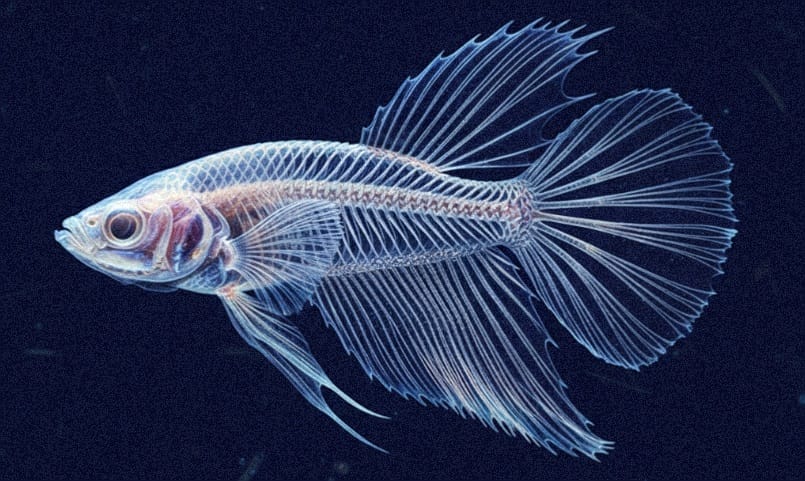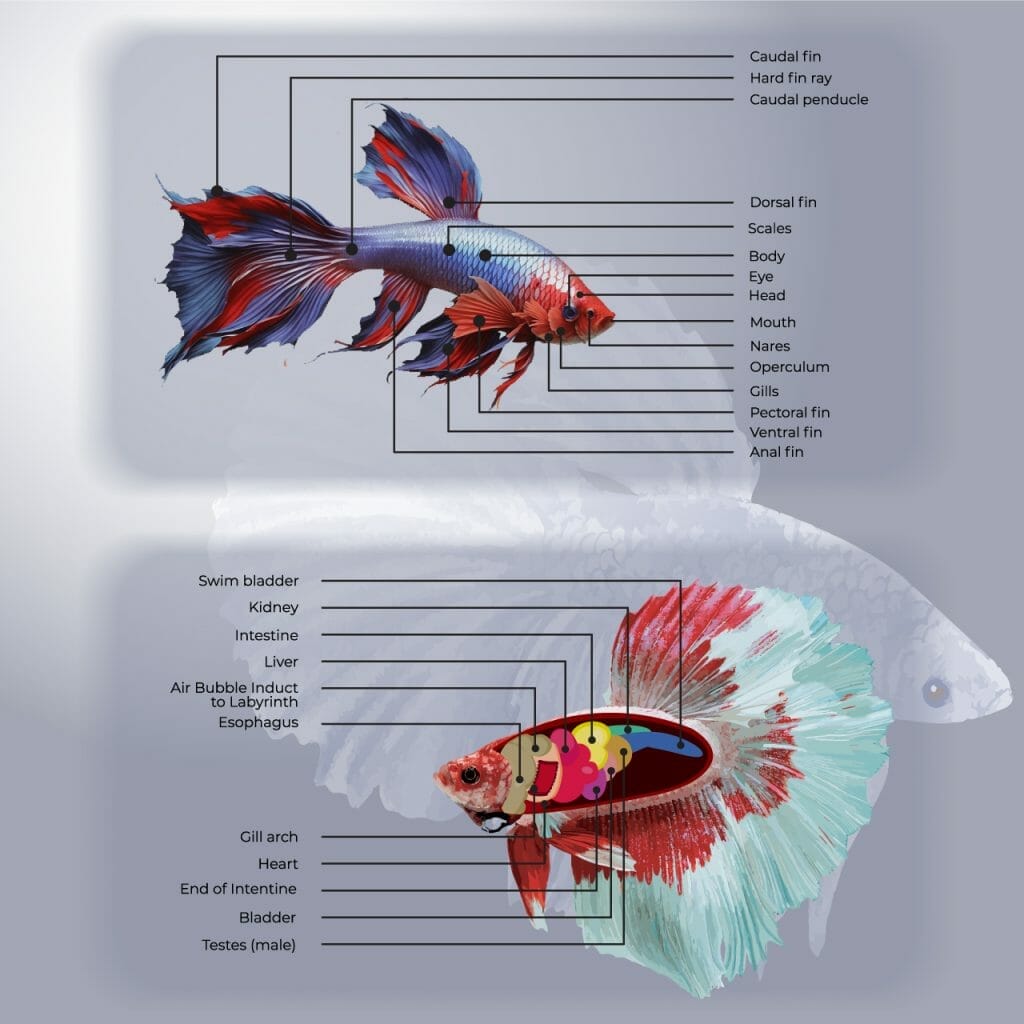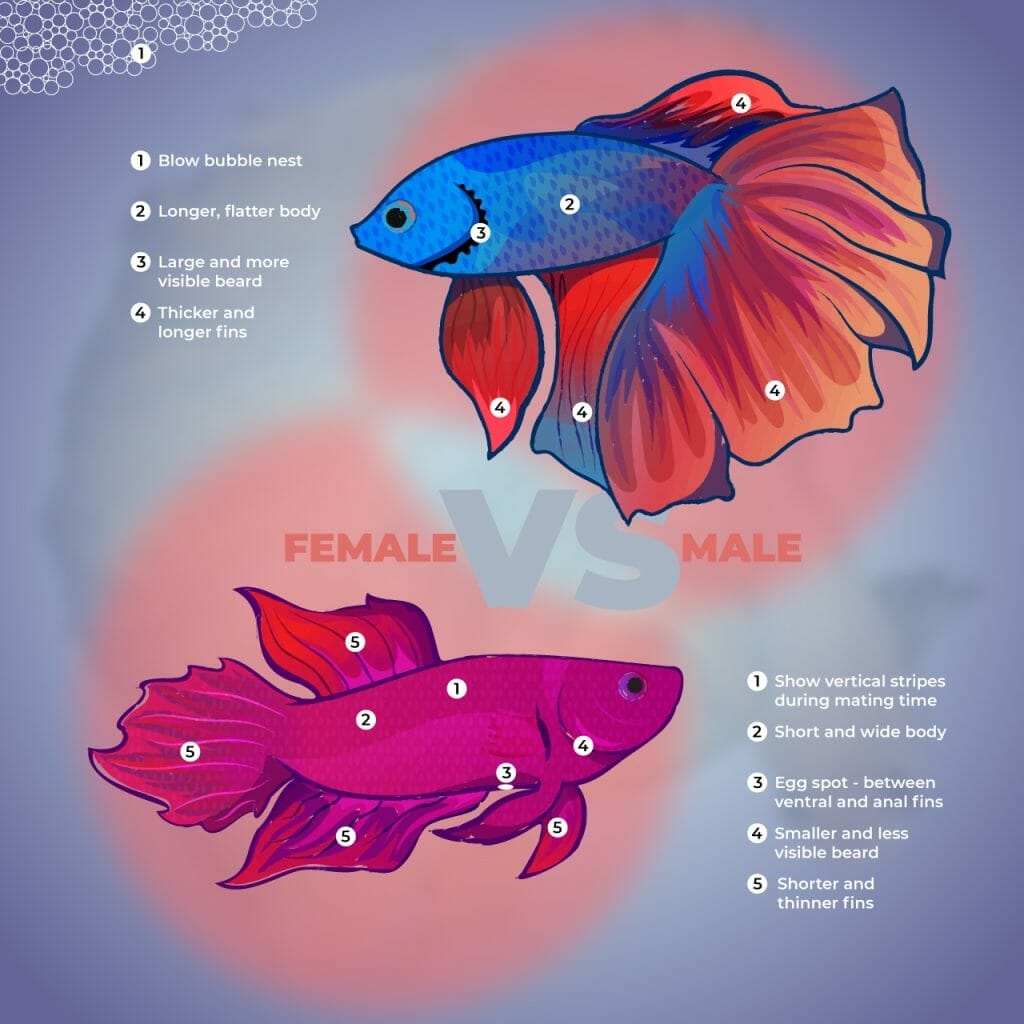This post was created with help from AI tools and carefully reviewed by a human (Muntaseer Rahman) . For more on how we use AI on this site, check out our Editorial Policy.
Check Out These FREE Tools We Made JUST For You!
Betta Fish Anatomy Explained: Inside & Out Body Parts and What They Actually Do

You know those gorgeous betta fish swimming around in tiny cups at the pet store? Yeah, those little guys are packing way more biological weirdness than you’d expect from something you can buy for $5.
Let me walk you through what’s actually going on inside and outside your betta, because honestly, these fish are built different.
The Outside: What You Can Actually See
The Mouth That Does Everything
Bettas have upturned mouths that make them look permanently grumpy, but this design helps them eat from the water surface.
And get this: their jaws are proportionally bigger and stronger than a white shark’s. I’m not kidding.
Inside that tiny mouth are rows of pointed teeth that work like a paper shredder. When bettas fight, they latch onto fins and don’t let go, tearing chunks right off.
But here’s the wild part: behind those razor-sharp teeth is a gentle space where male bettas hold their babies without hurting them, then carry them safely to bubble nests. Same mouth that shreds fins can cradle eggs like they’re made of glass.
Eyes That Sleep With You Watching
Bettas can see in two directions at once but can’t focus on both things at the same time, and they’re nearsighted—only seeing clearly up to about a foot away.
Oh, and they sleep with their eyes wide open because they don’t have eyelids. So yeah, your betta’s watching you even when it’s unconscious. Not creepy at all.
The Beard That Means Business
Male bettas have this membrane under their gill covers that most people call the “beard.”
When they flare up to fight or show off, they spread their gill plates wide and extend this membrane to look bigger and scarier. It’s basically the fish equivalent of puffing out your chest, except it actually works.
The membrane color usually matches the body—dark in blues and reds, lighter in pale fish.
Fins: The Good, The Bad, and The Halfmoon
Bettas have five types of fins, and each one does something specific:
Dorsal Fin (top fin): Keeps them stable and helps them turn—without it, they’d swim crooked and struggle to go anywhere.
Caudal Fin (tail): Provides power and acts like a rudder, but those gorgeous long tails are actually a problem. They slow bettas down and catch water currents like parachutes, so your fish gets pushed around the tank. Wild bettas have short tails for a reason.
Anal Fin (bottom): Works with the dorsal fin to keep the betta stable while swimming.
Pectoral Fins (side fins): Used for turning and moving forward.
Ventral/Pelvic Fins (bottom front): Handle the fine motor skills like sharp turns, going up and down, and stopping.
Here’s something crazy: betta fins are only a few cells thick, so they tear and fall off easily. Sometimes halfmoon bettas with huge tails will just “blow” their tails—the whole thing falls apart. It grows back, but never looks quite the same.
Male betta fins keep growing their whole lives, while females stop developing fins after a while.
The Lateral Line: Fish Spidey-Sense
Running down each side of your betta are tiny pores that make up the lateral line system—it detects movement, vibration, and pressure in the water.
Inside those pores are hair cells in a gel-like substance that pick up vibrations and send signals to the brain. This is how fish school together without crashing and how they feel your net coming from behind.
Tapping on a fish tank is like having your body pressed against multiple speakers. Don’t be that person.
The Inside: Where It Gets Weird
The Labyrinth Organ: The Superpower
This is the big one. Bettas have a specialized organ called the labyrinth located behind their gills that lets them breathe air directly from the surface.
The organ literally looks like a maze inside—it has rosette-shaped plates with thousands of oxygen-absorbing blood vessels. Air gets trapped in folds that look like a sponge, then absorbed into the bloodstream.
This evolved in stagnant, low-oxygen waters, which is why bettas can survive without bubblers or filters that other fish need.
But here’s the catch: just because they can breathe air doesn’t mean they should live in tiny tanks—they still produce the same amount of waste as other fish. That cup at the pet store? Not okay.
In fact, if you remove the labyrinth organ, bettas die from suffocation even in oxygen-saturated water. They literally need both systems.
Everything’s Crammed Up Front
All the important stuff—brain, heart, stomach, liver, spleen—is packed into the first third of the body behind the head.
The back two-thirds? Just spine, flesh, and swim bladder. It’s like they front-loaded all their organs and said “good enough.”
The Swim Bladder: Nature’s Ballast Tank
This gas-filled organ looks like a long clear balloon running along the spine. It lets bettas stay upright and swim to different depths by adjusting how much gas is inside.
Without it, your betta would just sink to the bottom like a rock.
The Tiny Stomach Trap
A betta’s stomach is about the size of its eye.
So when people overfeed them because “they look hungry,” you’re basically stuffing a tennis ball into a thimble. This is why bettas get constipated and bloated so easily.
Heart, Liver, and All That Jazz
Bettas have familiar organs like liver, intestines, kidney, bladder, esophagus, and heart—all crammed between the head and anal fin.
The liver secretes bile to break down food, especially the tough protein bettas eat. After the stomach breaks down food, the intestine absorbs nutrients like protein and vitamins.
The esophagus connects to the mouth and passes food, water, and air to other organs. The gill arch works with the esophagus to pass air to the labyrinth organ.
Male vs. Female: Spot the Difference
Body Size: Males are bigger than females.
Fins: Males have those long, flowing fins we all love. Females have shorter, more practical ones.
The Beard: Females have smaller beards that don’t stick out as much.
Egg Spot: Females have a white spot near the anal fin called the ovipositor—that’s where eggs come out during spawning.
Behavior: Males build bubble nests and are way more aggressive. Females are chill in comparison.
The Bottom Line
Bettas are basically small aquatic superheroes with built-in scuba gear, shredder teeth that double as baby carriers, parachute tails, and bodies that are 60% spine.
They can see you from two angles at once while sleeping with their eyes open, and they feel vibrations through their whole body using their lateral line.
Next time someone says “it’s just a fish,” you can hit them with the fact that bettas have proportionally stronger jaws than great white sharks and an organ that literally evolved to let them breathe like we do.
These little guys are way more impressive than they look, and now you know exactly why.
About Author
Hello, I’m Muntaseer Rahman, the owner of AcuarioPets.com. I’m passionate about aquarium pets like shrimps, snails, crabs, and crayfish. I’ve created this website to share my expertise and help you provide better care for these amazing pets.
Disclaimer
This site is owned and operated by Muntaseer Rahman. AcuarioPets.com is a participant in the Amazon Services LLC Associates Program, an affiliate advertising program designed to provide a means for sites to earn advertising fees by advertising and linking to Amazon.com. This site also participates in other affiliate programs and is compensated for referring traffic and business to these companies.



